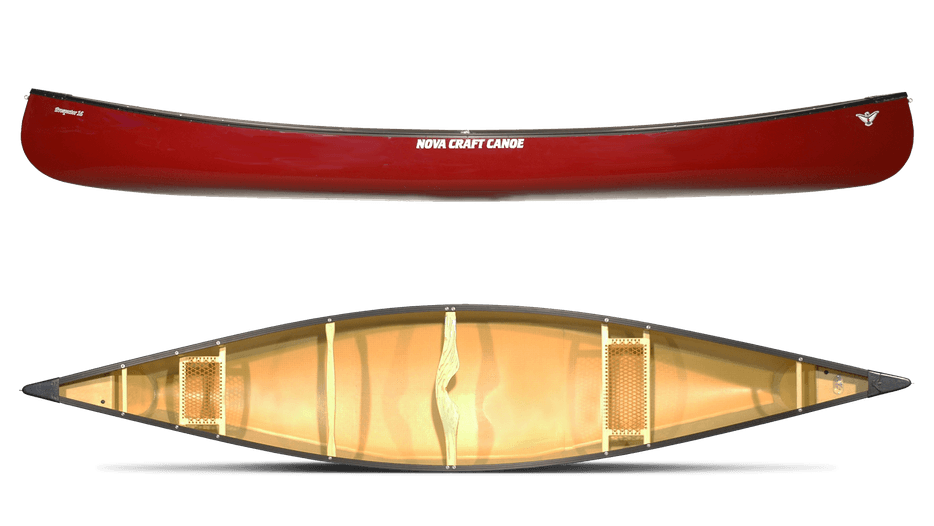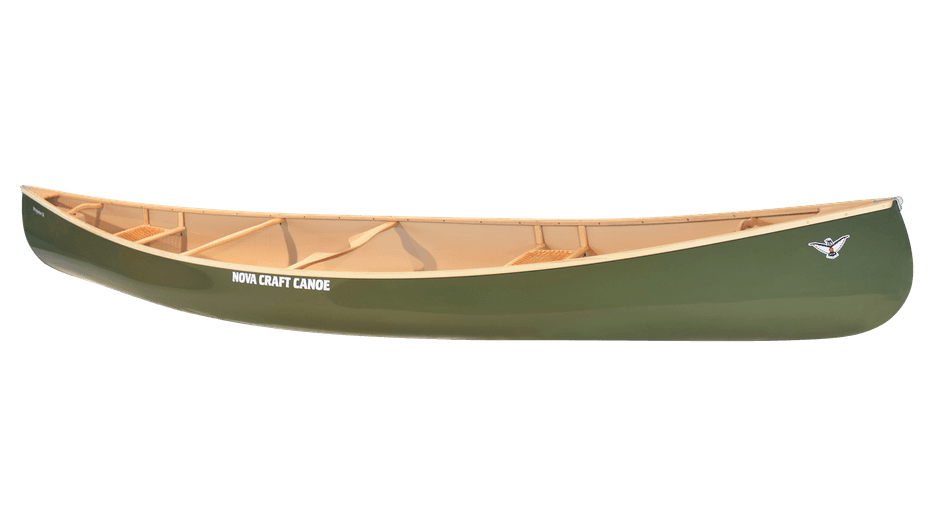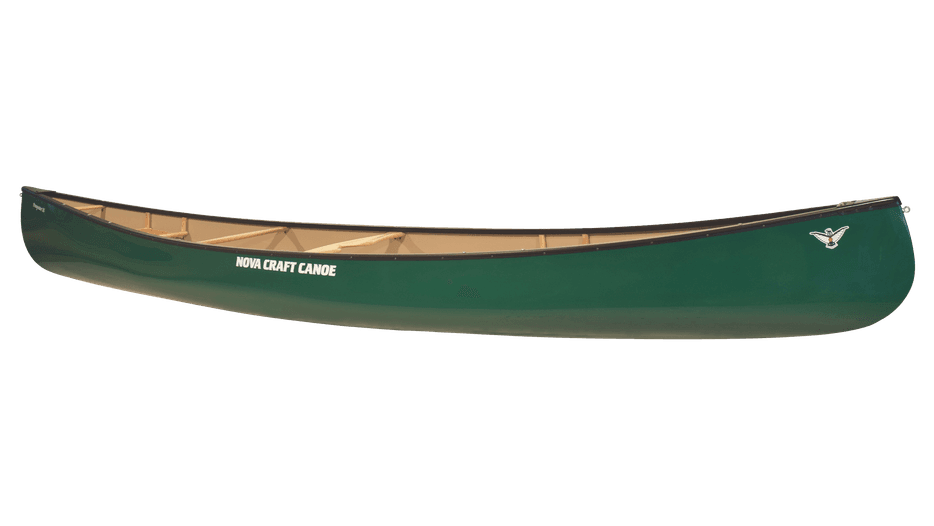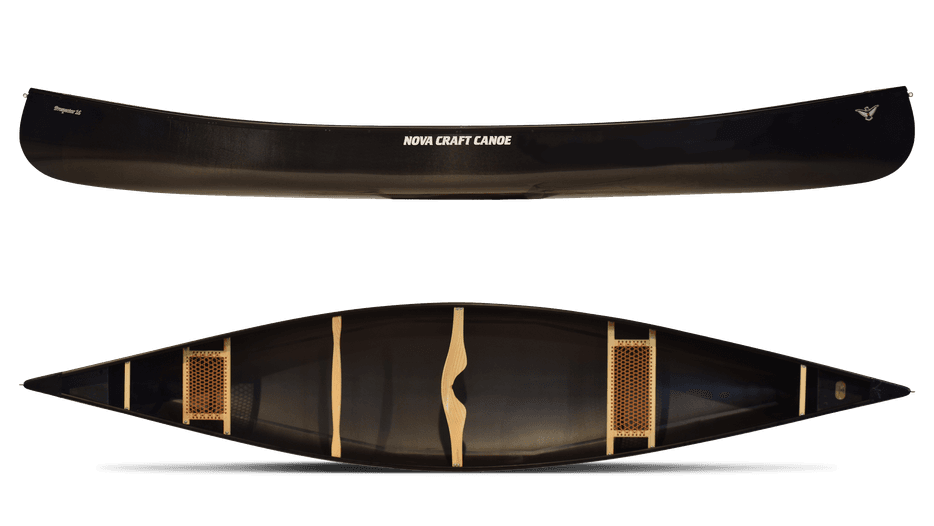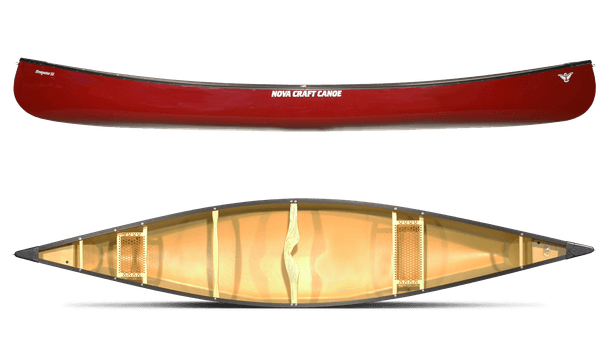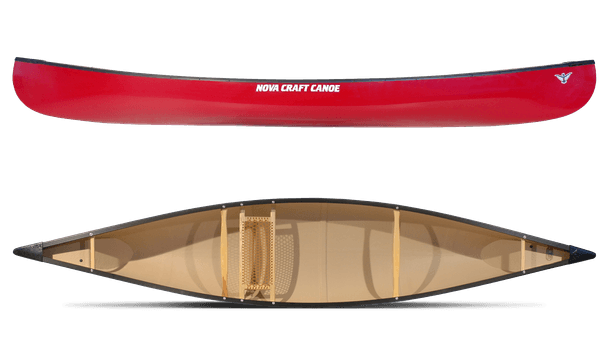- Home
- Gear & Reviews
- Prospector 16
Prospector 16
Prospector 16 Description
The Chestnut Prospector has probably been described more often in text than any other canoe, it’s just that popular. Our version of this venerable craft is faithful to the original. Since 1984, we’ve gone out of our way to continue the tradition so future generations of paddlers can enjoy this icon of Canadian history.
The Workhorse of the Canadian north, our Prospector 16’ feels most at home loaded with gear on a remote wilderness lake or river. While it is best suited for river tripping, it remains versatile enough to be a good all round canoe. With experience, the self-righting aspects of the shallow arch hull will become apparent and confidence levels will soar. Whats more, it provides a very dry ride in big waves and whitewater. It is simply the best all round wilderness tripping canoe available. Shown in Aramid.
- More information about Prospector 16
- View all products from Nova Craft Canoe
Prospector 16 Specs and Features
- Structure: Rigid / Hard Shell
- Seating Configuration: Tandem
- Ideal Paddler Size: Average Adult, Larger Adult
- Skill Level: Beginner, Intermediate
- Ideal Paddler Size: Average Adult, Larger Adult
- Skill Level: Beginner, Intermediate
Where to Buy the Prospector 16
Learn More
Nova Craft Canoe
Prospector 16 Reviews
Read reviews for the Prospector 16 by Nova Craft Canoe as submitted by your fellow paddlers. All of the reviews are created and written by paddlers like you, so be sure to submit your own review and be part of the community!
I bought the Nova Craft…
I bought the Nova Craft Aramid version (2021) as I wanted a light weight canoe that I can carry easily. I will say that this is a joy to pick up and portage. As to its handling, a canoe modelled on the classic Chestnut Prospector should behave as such. There's little need to extoll those attributes.
However, I am disappointed with this canoe. I immediately noticed that the aluminum gunnels had bulges and hollows. Paddling solo, I was unhappy with the fact that the canoe did not heel over comfortably. I soon saw that the hull was poorly shaped as it actually flared out, the tumblehome was reversed. Measurements from my cedar Chestnut canoe showed that the factory had installed a center thwart that was 2-1/2 " too wide and it had somehow passed inspection. I had to take out both thwarts, re-cut and drill them using the right dimensions. This improved but did not entirely correct the shape. A showroom model with ash trim did not have the same issues, so whether this flare is a problem with all aluminum gunnels or is just more poor workmanship on mine I can't say.
The normal sliding this canoe out of a wooden canoe rack and launching it from a wooden dock have resulted in rub marks in the gel coat that the fibers show through. I polished some of these with car wax to see if it was only the surface colour but the weave is still visible. Thick layers of resin obviously will weigh more but this is so thin it fails even with kid glove, new canoe handling on easy day trips. As well, aftermarket plastic gunnel protectors are needed as the powder coating scrapes to bare metal given any contact with a vehicle roof rack.
I love my new boat. I paddled…
Three years now with my…
Three years now with my Prospector 16. I have found a comfortable posture and balance for soloing, difficult to do a good stable hard lean but I've found a way around that. Takes lots of weight when needed. Tracks well, steers well, sits high on the water. Overall fast, comfortable and especially light and portable which was the deciding point for this aging heavy guy. Really enjoying it.
This review is for the Nova…
This review is for the Nova Craft Prospector 16 in Tuffstuff Expedition layup. Our boat was manufactured in 2017 and weighs 61 lbs. It is the ninth canoe my wife and I have used in Midcoast Maine since 1976.
After two years of putting this boat to the test, we conclude that the Prospector 16 is very capable for its size. It is well-suited for waterways where carries are common and a wide range of conditions are encountered.
To understand what this boat does well we need to examine its form. The hull is symmetrical in shape with a shallow arch bottom. The beam and floor are wide and the bilge is round but not too soft. The sides are vertical. The bow and stern are full, yet the stem is sharp and cleaves the water nicely. The hull has just the right amount of rocker.
These features allow the boat to paddle backward as easily as forward. The bow and stern rise over the waves. The boat can be turned quickly in any direction. In the wind it stays on track simply by adjusting the trim. The vertical sides and the wide floor and beam enable the boat to pole well and to carry a heavy load comfortably.
Extra weight in the Prospector 16 often improves its performance. On large lakes and the ocean a heavier load helps the boat maintain speed and momentum in the face of wind, waves and currents. Extra weight can also be used to adjust the trim. On day trips where we have little gear on board we bring a 5 gallon collapsible water jug for ballast. It can be moved forward or backward in the boat easily and can be emptied and refilled as needed during portages.
In the rapids, the deep hull, wide beam and rocker on the Prospector 16 make it possible to ferry, stop midstream, make quick turns, draw parallel to the current and lean downstream. The result is that running Class 1 and 2 rapids is easy. Running Class 3 rapids requires more skill but the Prospector 16 still handles well in spite of the bigger waves and stronger currents.
The Prospector 16 is a good poling boat with one person on board and a light load. In this configuration, about the only limit to what the boat can do is one’s skill and stamina. On the other hand, with two people and gear on board, the Prospector 16 becomes more difficult to handle. This is normal for smaller canoes. We can pole up and down Class 1 rapids rather easily, but we can ascend Class 2 rapids only by going solo. Ascending Class 3 rapids with a load is out of the question.
A boat’s speed indicates a great deal about the form of the hull and its efficiency in moving through the water. Our average speed in the Prospector 16 paddling tandem on calm water is 3.4 mph and our maximum is 4.7. After testing nine canoes in this manner, we would classify the speed and efficiency of this hull as about average.
The Prospector 16 will be a little more tiring to paddle during long trips on flatwater than a canoe designed for greater speed. On the other hand, in rough water, we have found it to be just as fast as modern designs with asymmetrical hulls and narrow beams. For example, in a seven mile test on the coast of Maine under similar conditions of wind, waves and tide, both the Prospector 16 and the Wenonah Escape completed the course at the same overall speed of 2.9 mph. The difference was that the Prospector 16 was easier to handle in the waves and provided a smoother and more comfortable ride overall.
There are a number of other boats on the market called Prospectors. Most of them have little in common with the Nova Craft canoes of the same name. In this category we would place the Wenonah Prospector 16 and the Swift Prospector series of canoes. These boats have narrower ends, narrower floors and softer bilges than the Nova Craft Prospector line.
Features like these boost speed at the expense of the stability that makes the Nova Craft canoes so useful in whitewater, on the open ocean, for carrying a heavy load and for poling. For our purposes, the Nova Craft Prospectors are a better choice, but other people may prefer slimmer and faster boats for the kind of paddling they do most of the time.
An exception to the rule above is the Wenonah Prospector 15. The Royalex version that we purchased in 2013 is similar in form to a Nova Craft Prospector, but the hull is not as deep. It is a wonderful little boat with many uses and we are very fond of it.
The additional details provided below may be useful in deciding whether this canoe is the right one for you.
When paddling solo on flatwater one can sit on the bow seat facing backward. In rapids it is wiser to kneel in the center of the boat with the yoke in front of you.
As in all canoes, attention to the boat’s trim is critical. Gear and water should be moved forward or backward in the boat as needed depending on conditions.
Waxing the hull not only protects the gel coat from sunlight but it also helps the boat slide easily over fallen trees and through tangles of shrubs and branches while portaging.
The yoke can be turned around to face the stern. By so doing, the rear thwart can be used to stabilize the canoe with one hand while portaging. We prefer this method to holding the gunnel or using a tumpline.
The yoke provided by the manufacturer was beautifully made, but it was too wide for for us to grip firmly while swinging the boat onto our shoulders. We replaced the yoke with a narrower one that is easier for us to hold onto.
We like the rings for painters on the bow and stern. We use the painters for tying the boat to shore and for retrieving the boat if it starts to blow away during self rescue drills on a windy lake or bay.
For tracking and lining the boat from shore we do not use the rings. Instead, we attach bridles to the bow and stern seats as described by Garrett Conover in “Beyond the Paddle”. These lines pull the boat from the bottom of the hull instead of the top, ensuring better safety and control.
During a sharp impact the gel coat tends to flake off in small pieces while leaving the fabric beneath undamaged. On kevlar hulls we have owned, similar impacts caused gouging of the gel coat and sometimes long tears in the fabric. The Innegra hull on the Nova Craft Prospector 16 is stronger and more resilient but the chips in the gel coat should be repaired periodically.
Nova Craft manufactures the Prospectors in lengths from 15 to 18 feet. Compared to the Prospector 16, the 17 and 18 foot models should be faster and provide better glide and momentum. On the other hand, their extra size and weight will make them more difficult to carry.
We have had a fibreglass…
We have had a fibreglass prospector with ash trim for 21 years and absolutely love it! It goes. Roth to the cottage each year and has seen many rivers and creeks locally. It is a great canoe, both solo and tandem. It has many “memories” on it, but we take good care of her and baby her. The ash trim gets Tung oiled every year and she is stored in the garage. Whenever we are out with her, we get lots of compliments. People can’t believe it is a 21 year old canoe! My husband was seriously considering going to a solo Fox because of the weight (we are getting older), but after two weeks of paddling at the cottage has changed his mind. He can still handle the Prospector and the grandkids love to go paddling with Papa! We definitely recommend the Prospector and Nova Craft. The people there are great to deal with
We purchased this canoe two…
We purchased this canoe two summers ago and have had nothing but regrets. We have spent more time trying to repair the gel coat than actually canoeing. We are older, experienced canoeists who only canoe flat water. However, after two seasons and several repair jobs, including skid plates, we are unable to use the canoe as the gel coat continues to deteriorate, even after several repairs (which are time consuming, onerous and tricky). Sure, you can drop the canoe from a 10-story building (as their video suggests), but the gel coat will be completely mangled and require endless hours of restoration, even if the underlying layer of 'tuff stuff' is intact. We would not recommend this canoe to anyone - better to go online and buy a used Royalex.
We've had a Trailhead in our…
We've had a Trailhead in our family for years. The 16' has been our favorite. We take out our handicapped son fishing in it. It's been on some of the craziest rivers in the Yukon. It's a great all-round canoe that is dependable, tough and responsive. It's definitely a keeper and would recommend it for any kind of canoeing you do!!
Novo Craft Canoes - the Long View: I purchased a 16' Prospector Royalex…
I purchased a 16' Prospector Royalex Lite Nova Craft Canoe on March 11, 2007 c/w with the ash trim (for which I paid an extra $325) and lace seats (paid $100 extra) from Totem Outdoor Outfitters in Edmonton
When the canoe arrived at Totem the outwale at the stern, LHS was not flush with hull but was sprung out ~ 1”. Totem tried to fix this by inserting another screw into he deck plate further towards the stern to pull the outwale in. This still left the outwale sprung from the hull ~ 1/4", plus I now had an extra countersunk hole in the outwale. Given the choice of shipping the thing back to London Ontario and waiting several weeks for delivery of a repaired or new canoe, I chose to take the 10% discount on the purchase price offered by Novo Craft.
The first winter, as per the Nova Craft instruction booklet, "Storing Your Canoe" section, I removed the first "8 or 10 screws from each end of both gunwales" and removed the deck screws and lifted the ends of the inwales above the hull in order to allow for the difference in shrinkage between the hull and the wooden gunwales due to low temperature. When I did this I found that the inwale was split at each screw hole, apparently because Nova Craft had failed to drill pilot holes through the inwale to accommodate the screws. I also found that one of the screw holding the outwale had missed the inwale completely.
Furthermore, in researching the Novo Craft "Care of Gunwales" where they recommend that the woodwork be treated with Tung Oil "three or four times a year", I found that Tung Oil is a furniture finish and hardly suitable for protecting/waterproofing wood for outdoor service. In fact the Lee Valley brochure on Tung Oil states that in order to get Tung Oil treated wood to a water resistant state, one must apply 10 coats of Tung Oil, with 24 to 48 hours drying time between coats. It's supposed to be a canoe, not a dining table! Also, Nova Craft does not mention the issue with the untreated wood between the hull and the inwale or outwale, which is well known to trap water and never dry, leading to rot. The only way around that issue is to either remove the inwales and outwales and treat the inside surface as well or to seal these surfaces from water ingress completely.
This year, August 2016, I removed all the woodwork for Tung Oiling and repair of the split inwales I also removed the bow and stern wooden carrying handles. To my dismay I found that the screws through the inwales into the carrying handles only penetrated the handles by 1/4". While this may hold the handles in place for a straight upward pull it is not a robust attachment for pulling forward or backward or for attaching a bow and stern line for holding the canoe in place when car topping.
I would rate the workmanship on these canoes as "no pride" and the serviceability of these canoes as 2 to 3 seasons-sunshine only. Either that or I was unlucky enough to pay $2114 for a canoe made on either a Friday or a Monday.
Dear SSM,
Sorry to hear you are not happy with your canoe after using it for 10 seasons. I don't remember this canoe in particular but looking back in our records, I see we did give Totem a discount for a blue P16 - RL with ash trim in April of 2007. Not sure why you would be charged $100 for the lace seats as they are standard in most of our canoes and our invoice to Totem shows no upcharge.
We use Tung oil on our ash gunwales because we found that using a waterproof finish such as spar varnish led to more problems when water that did get into the wood could not escape causing the wood to rot prematurely. The oil finish is more maintenance but they last longer. You didn't mention where you have stored your canoe but we definitely recommend ash trimmed canoes be stored inside out of the elements when not in use.
I'm not sure whether your canoe was damaged in shipping but Totem and Nova Craft did offer a discount which you accepted. As well the trim has worked for you for 10 seasons even with taking it apart in the winter to prevent frost cracks. While you have it completely apart perhaps you would like to replace the trim with aluminum gunwales which are more maintenance free. If you email me at tim@novacraft.com we can work out the details.
You didn't mention how your canoe has been for paddling. I hope you have enjoyed paddling it as much as the other reviewers on this site. Ignoring any resale value, after 10 seasons it has cost you $211.40 per year. I'm sure with the care you are taking with your canoe it will last you easy another 10 or 15 years. Really not too bad of an investment.
If you would like to replace the trim or discuss any other matters concerning your canoe, please drop me a line at the above email and we will do our best to look after you.
Best Regards,
Tim Miller - Nova Craft Canoe
I just picked up my 16'…
I just picked up my 16' Prospector in Aramid lay up and have been absolutely thrilled. I first put it in the water with my wife and we paddled it tandem. It tracked just as straight as an arrow and required very little adjustment. Then I took it out solo and it was a dream. The additional rocker over my previous tripping canoe was a vast improvement.
The staff at the London Paddle Shop were outstanding. The canoe came standard with a deep yoke, bootlace seats and iodized aluminum gunwales. Best of all, I can hoist it onto my shoulders with very little effort at all. No sense having a great canoe if you can't pick it up.
Light! I'm a strong woman,…
The Prospector tuff exp. 16…
I purchased a 16' fiberglass…
Hands down, an excellent…
I recently purchased the…
I am a strictly solo paddler. I like having a strictly solo boat so people don't ask to ride with me. I like to stand and paddle, and I like to pole. I like to kneel and I like to sit back and slack off. But there is nothing more uncomfortable to me than to be headed into rapids in a boat I can't turn. I've taken out various angling and recreational boats by very reputable companies, and I have been miserable because I can't spin them on a dime when I needed to. I'd give up every other criteria in order to be able to turn because it just feels unsafe. After 8-day tripping for a long time in a whitewater boat, this was something I just can't compromise.
The Prospector performed better than I had hoped. It actually paddles better with a load, still feeling light and agile even with a weeks worth of gear, a kid and a childs kayak riding on top. Tight for but doable. I'm a 33 yo woman, moderately fit, and even after 12-14 hour days on the water, 21 mile paddles, I didn't feel worn out at the end of the day.
It tracks pretty well, And it steers beautifully. Initial and secondary stability were very comfortable for me, and it allowed me to stand up through rapids to check on the kids progress, shout directions, or just stand up and stretch my legs through long flat sections. Handled Class I-III rapids wonderfully, and was truly a joy to ride.
The craftsmanship is truly impressive. It is a beautiful canoe, and the laced seats are gorgeous and comfortable. It is very easy to portage, and the lighter weight really made a difference when loading this boat solo over my head. The extra wide yoke and spine notch make it extremely comfortable to carry, as I found myself needing to carry this boat up hill about 100 yards. It was surprisingly easy.
We handled a pretty serious thunderstorm on the river, and I felt quite confident in high winds. The high gunwales do catch a lot of wind, and it does blow around, but it makes for a dry ride and it's difficult to dip a rail and swamp this boat, a trade off I'm happy to make.
All around, it tracks great in the flats, heels over great to paddle in the Canadian style, smaller rapids were fun, hauls everything and makes an outstanding kid wrangler. The only downside was the price, the only reason I gave it a 9- but I feel confident I'll have this boat for 25 years, and sometimes in life, you get what you pay for. I couldn't be happier with this canoe and I'd recommend it to anyone looking for something to do it all.
Have owned the 16 foot…
Just purchased the Prospector…
The 16' Prospector model is…
My camp is a serious tripping…
Been paddling and poling my…
Other than the fact that I get a few more scratches on the bottom with the Prospector, it is faster and more stable than the OT Camper, as well as easier to solo. It is much faster and a more stable than the Fisherman, although more effected by the wind - and pretty much makes up for the lack of comparable maneuverability when leaned aggressively for tight turns (which is easy, due to the wonderful secondary stability of the Prospector).
Compared to the Old Town Penobscot, the NC Prospector gives up some speed and some tracking ease. The Prospector is a little better in secondary stability - but not much. It is more effected by wind than the Penobscot, since the Penobscot has a lower profile and very little rocker. But the Prospector is much drier in the rough, due to it's rocker, it's fuller stems, and higher profile - and easier to turn, also due to it's moderate rocker.
If I had to limit myself to one tandem canoe in the ~$1400 and under price range, it would be a tough decision between the Prospector and the Penobscot. The Penobscot is the better flat-water boat, but the Prospector is better for the rougher stuff. I consider them both to be among the better, if not the best, all-around Royalex canoes - with each leaning slightly to opposite ends of the spectrum but considerable overlapping in their range of suitability. Both boats can be poled easily (the Prospector, more easily climbs drops because of it’s rocker), and both can be paddled solo with relative ease. Both are well-constructed and show little or no "oil-canning." Fortunately, I don't have to choose. I do believe that you can cover most general tandem canoe needs with these two boats - as long as you can stand the weight.
Weight is more of an issue here, since my Prospector is the "standard" (heavier) Royalex lay-up. Wouldn't have been my first choice if I was buying new at list price, but mine was left-over stock and I got a great deal on it. This heavier (74lbs) lay-up has shown to be really tough though. Although the bottom is now pretty much covered with surface scratches and a few small dings, it seems to be holding up to my rough treatment with no sign of any damage that might need attention. It as taken some practice - but I find that I can lift and carry the boat by myself pretty well, so long as I don't have to carry it far. The contoured Nova-Craft yoke really helps in that.
My wife and I are still "novice" paddlers, in my estimation. We haven't done anything bigger than higher class 1 tandem, so I can't speak to tandem whitewater performance. But we find the Prospector to be confidence-inspiring and easy to handle in tricky river current. We are learning tandem eddy-turns, peel-outs, back-ferries, and such with no real difficulty in this boat. I have done some cl2 water solo with paddle and with pole, and find it well-suited for that. This is now my primary poling canoe and will likely remain so until I replace it with a lighter composite. I'm not sure if we will go with a composite Prospector at this point, but that is highly likely.
I really like the Nova-Craft seats. They are comfortable and easy to maintain/repair - and they are quiet (no squeaking, as we've seen with the seats on several other caned or laced canoe seats). I also like the fact that Nova-Craft puts grab loops through "tug-eyes" on their boats. And the yoke gets not one, but two bolts on each end into the gunnels. Great construction. Built to last. Although I know it saves some weight - I would prefer not to have the simple individual seat drops, but would rather have "truss style" drops for added rigidity. The Nova-Craft seat drops are more substantial than those that came on my Old Town canoes though, being heavier rectangular stock rather than simple round dowels. Recently, I added a kneeling thwart in the place of the standard thwart ahead of the rear seat - and eventually, I will replace the stock seat drops with truss drops. So my Prospector might be a couple pounds heavier than stock, but I think it will be worth it.
So - if you plan to spend most of your time on moving rivers cl1+ to at least cl2 (and probably a bit higher) the NC Prospector is easily up to the task. Probably one of the best all-around tandem designs for moving and twisting water. Not so much for lakes and other big flat water, although competent there as well (especially with a load). I give this canoe a 9 - only because of the seat drops and because the Nova-Craft Blue Steel composite version should be every bit as good or better in every respect (except the higher price) - with less than 2/3 the weight.
This is a fabulous boat. I…
I just purchased my…
I bought my Nova Craft…
I would rate this canoe a 9.5/10 as is and if I could afford a custom build, to add a few minor changes I would give it a full 10/10. If you can only afford one canoe and you want it to do everything and last a life time, buy the Nova Craft Prospector.
I purchased my Nova Craft…
I have test-paddled this boat…
This boat strikes me as handling and tracking pretty well, but I was testing it solo, with no load on a windy day and a shallow lake, so I had to work to control it. I imagine it would be much easier to steer with a bow paddler and even a light load.
Nova Craft is probably the best Canadian canoe maker and is upping its profile in the US canoe market, and runs with Mad River and Wenonah. Nova Craft is already miles ahead of Old Town in its boats. Nova Craft has designed some good hulls, including the hi-tech Retro Chestnuts, Bob Special and Prospector, and makes a good fit and finish boat. The Royalex Lite is a nice compromise for those who want Royalex's durability but not its heavy weight.
I am a little confused whether the NC Prospector 16 in Royalex Lite weighs 59 lbs. or 64 lbs.? I have seen it advertised at both weights, and the seller whose boat I tested told me 64 lbs. I was able to handle the boat better than my 75-80 lb. Explorer 17, and to get it up over my head and onto a car, so even if it is 64 lbs., it is quite a bit lighter than the Explorer, which is made of full thickness, bomb-proof, Royalex.
Plus, my seller's boat had vinyl gunnels and skid plates, which he puts on all his boats, standard and which add a pound or two to the weight. I do not know if you need skid plates initially on a Royalex Lite boat, especially if you do not plan to drag over or run into a lot of rocks.
At any rate, I am going to buy one of these boats and highly recommend it for all uses on lakes and rivers, based on my two test-paddles.
I bought a prospector 16 this…
Dan, since outfitting a boat…
Best boat ever. I love my…
I've had my Prospector 16 for…
Greg
I bought a used royal lite…
Prospector 16 Kevlar/Spectra…
OK, I own an Old Town Tripper…
No, it is not as quick and nimble as the Bell, nor will it haul 1500 lbs like the XL, but it will hold its own quite respectfully in all conditions. I have been solo and light playing at different angles to the wind and actually got it to sail up wind with it heeled over to the lee side. This boat does not let me down in any aspect.
The most surprising thing about it was how comfortable it was to portage. I have fun with the other boats, and enjoy each ones special purpose, but when I don't know what to expect, I take the prospector. I can't recommend it enough. Only downer is the stupid rope pulls in the bow and stern. The dealer in Cabin John, MD gave me the best deal.Have fun, be safe, go far, u can do with this boat.

